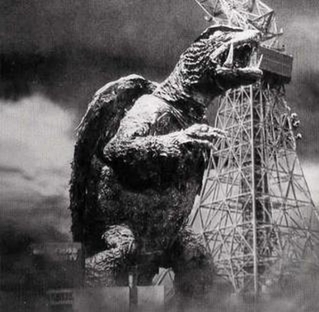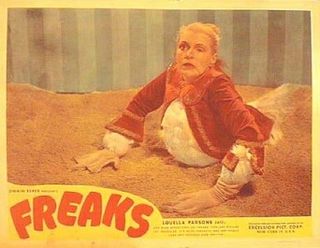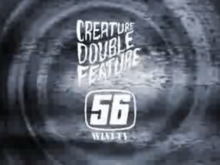Air times
Creature Double Feature usually aired on Saturday afternoons. Because it aired after the traditional Saturday morning cartoon time block, it introduced many younger viewers to classic (and not-so-classic) monster movies. In other cities it aired either on Friday night or Saturday night.
Boston
Beginning in 1972 a station in the Kaiser Broadcasting (later Field Communications) chain, WKBG (Channel 56; WLVI after The Boston Globe sold their share back to Kaiser in 1975) aired its collection of Godzilla movies—one per week at 4 p.m. on Saturday under the title, The 4 O'Clock Movie. They cycled through their collection twice, noticing that the broadcasts were especially popular with youngsters. Then, they started showing the films at midnight, calling it Creature Feature. The ratings became so popular that the show was moved to noon to increase its ratings. However, it was in direct competition with WCVB-TV's Candlepin Bowling and was moved to the 2 p.m. time slot. Its popularity grew and they tweaked the title to Creature Double Feature and changed its start time to 1 p.m. The show quickly became a staple of the station's Saturday programming schedule during the 1970s and early-1980s. Although the exact date of the final show is currently unknown, it seems to have petered out sometime in 1983 and was replaced with WLVI-TV's Martial Arts Theater, showing cheap English-dubbed Hong Kong martial arts movies, as a replacement.
To this day WLVI staffers report that they still receive more e-mail and phone calls about Creature Double Feature than anything else. In 2006, Channel 56's Steve Ratner was quoted in The Boston Globe as saying "I'm amazed at the following the show continues to have. It's just insane how many people come up to us and ask after the Creature Double Feature. Every day we get e-mails from people all over the country." However, the station is unlikely to revive the show on their own since that timeslot is usually used now for infomercials, from which the station makes a considerable amount of income. The main announcer on Creature Double Feature was a Channel 56 long-time booth announcer, Neil MacNevin. His radio/TV name was Tom Evans. He and an engineer named Press Campbell would create sound effects, echoes, wind etc. off the cuff during the weekly recording sessions for the movie and promos for CDF during the week. MacNevin says he still gets comments from some of the listeners from those days and really enjoys telling them about the sessions. MacNevin and Campbell retired from broadcasting in the early nineties.
In June 2006, the Boston Herald reported that Boston-area car dealership owner Ernie Boch Jr. would be bringing the show back to WLVI—in its original timeslot—on an occasional basis. The first program of the new series aired on June 24, 2006. The two films shown on this occasion were Godzilla vs. the Smog Monster and The Giant Gila Monster . Boch himself hosted the show in full makeup as The Ghoul, though the original show almost never had a host—only announcers (other than for a brief time when Rich Koz, the Son of Svengoolie out of Chicago, hosted the CDF in the early '80s). A second episode aired on October 28, 2006, featuring 1973's Horror Express followed by the original 1968 Night of the Living Dead . It was brought back again on October 27, 2007 with the American International Pictures' (A.I.P.) movies Gammera the Invincible (a.k.a. Gamera ) and Attack of the Monsters . The broadcast contained no pop-up ads during the films and no interruptions from any on-air talent personnel during commercial breaks. The Boston Globe's Sunday Edition of their TV guide printed the schedule of the two Gamera movie titles reversed in their time slots.
The show's original announcers were reportedly Ron Dwyer and Tom Evans. During most of its run in its later years, the show's announcer was Dale Dorman aka "Uncle Dale", a Boston radio personality at WRKO and at WXKS-FM who also frequently did voice work for 56's children's programming.
The intro/outro music used for Creature Double Feature throughout its run was Emerson, Lake & Palmer's "Toccata" from Brain Salad Surgery . WLVI has kept the song as the theme of the 2006 and 2007 revival. It is not yet known if current WLVI owners Sunbeam Television will continue to air the revival.

Kaiju is a Japanese term that is commonly associated with media involving giant monsters. A subgenre of science fiction, it was created by Eiji Tsuburaya and Ishirō Honda. The term can also refer to the giant monsters themselves, which are usually depicted attacking major cities and battling either the military or other monsters.

Gamera is a fictional monster, or kaiju, originating from a series of Japanese films. Debuting in the 1965 film Gamera, the Giant Monster, the character and the first film were intended to compete with the success of Toho's Godzilla film series. Since then, Gamera has become a Japanese icon in his own right, appearing in a total of 12 films produced by Daiei Film and later by Tokuma Shoten and Kadokawa Daiei Studio respectively, and various other media such as novelizations, manga, video games, and so on.

Nick at Nite is a nighttime programming block on the American basic cable channel Nickelodeon. The programming broadcasts from prime time to late night. The block initially consisted of syndicated sitcoms and films from the 1950s to the 1970s. Nick at Nite gradually shifted its programming to primarily airing sitcoms as recent as the mid-1990s to the 2010s.
In broadcast programming, dayparting is the practice of dividing the broadcast day into several parts, in which a different type of radio programming or television show appropriate for that time period is aired. Television programs are most often geared toward a particular demography, and what the target audience typically engages in at that time.

The ABC Sunday Night Movie is a television program that aired on Sunday nights, first for a brief time in 1962 under the title Hollywood Special to supposedly replace an open time slot for the TV show Bus Stop, which was cancelled after March 1962. It then began airing regularly under its more commonly known title from late 1964 to 1998, on ABC. Since 2004, it has aired sporadically as a special program, now titled the ABC Sunday Movie of the Week, though as of the 2011-12 television season, the only films in this timeslot were aired under the Hallmark Hall of Fame banner, which transferred to ABC in that season. However, in 2014, The Hallmark Hall of Fame moved exclusively to cable on the Hallmark Channel. As a result of this, the Sunday Night Movie is now exclusively relegated to two special holiday movies, The Sound of Music every holiday season and The Ten Commandments every Easter.

WCVB-TV is a television station in Boston, Massachusetts, United States, affiliated with ABC and owned by Hearst Television. The station's studios are located on TV Place in Needham, Massachusetts, and its transmitter is located on Cedar Street, also in Needham, on a tower shared with several other television and radio stations.

WSBK-TV is an independent television station in Boston, Massachusetts, United States. It is owned by the CBS News and Stations group alongside CBS outlet WBZ-TV. The two stations share studios on Soldiers Field Road in the Allston–Brighton section of Boston. WSBK-TV's transmitter is located on Cedar Street in Needham, Massachusetts, on a tower site that was formerly owned by CBS and is now owned by American Tower Corporation.
WLVI is a television station licensed to Cambridge, Massachusetts, United States, serving the Boston area as an affiliate of The CW. It is owned by Sunbeam Television alongside WHDH, an independent station. WLVI and WHDH share studios at Bulfinch Place in downtown Boston; through a channel sharing agreement, the two stations transmit using WHDH's spectrum from the WHDH-TV tower in Newton, Massachusetts.

The term midnight movie is rooted in the practice that emerged in the 1950s of local television stations around the United States airing low-budget genre films as late-night programming, often with a host delivering ironic asides. As a cinematic phenomenon, the midnight screening of offbeat movies began in the early 1970s in a few urban centers, particularly in New York City with screenings of El Topo at the Elgin Theater, eventually spreading across the country. The screening of non-mainstream pictures at midnight was aimed at building a cult film audience, encouraging repeat viewing and social interaction in what was originally a countercultural setting.

WUTF-TV is a television station licensed to Worcester, Massachusetts, United States, broadcasting the Spanish-language UniMás network to the Boston area. It is owned by Entravision Communications, which provides certain services to Marlborough-licensed Univision-owned station WUNI under a joint sales agreement (JSA) with TelevisaUnivision. WUTF-TV's studios are located on 4th Avenue, and its transmitter is located on Cedar Street, both in Needham.

WXTK is a commercial radio station licensed to West Yarmouth, Massachusetts, and serving Cape Cod. It has a news/talk format and is owned by iHeartMedia, Inc. The studios and offices are on Barnstable Road in Hyannis, while the transmitter is on Radio Lane in Yarmouth. WXTK is the direct descendant of Cape Cod's first commercial radio station, WOCB.
MeTV, an acronym for Memorable Entertainment Television, is an American broadcast television network owned by Weigel Broadcasting. Marketed as "The Definitive Destination for Classic TV", the network airs a variety of classic television programs from the 1930s through the 1990s.
Dale Dorman was an American Rock and Roll Hall of Fame radio disc jockey on WODS in Boston. Until September 15, 2008, he hosted The Breakfast Club with Dale Dorman weekday mornings from 5:30-9 AM. Dorman finished his career as a weekend personality with the station. "Uncle Dale" was inducted into the Massachusetts Broadcasting Hall of Fame in 2010.

Creature Features is a generic title for a genre of horror TV format shows broadcast on local American television stations throughout the 1960s, 1970s, and 1980s. The movies broadcast on these shows were generally classic and cult horror movies of the 1930s to 1950s, the horror and science-fiction films of the 1950s, British horror films of the 1960s, and the Japanese kaiju "giant monster" movies of the 1950s to 1970s.
William Robert Cardille, also known as "Chilly Billy", was an American broadcast personality from Pittsburgh, Pennsylvania. He was well known to regional viewers as a late-night horror host, but is perhaps more widely remembered for his appearance in George A. Romero's landmark zombie film Night of the Living Dead (1968), portraying a fictional version of himself; he also appeared as himself in the 1990 remake.

WJZB-TV, UHF analog channel 14, was a television station located in Worcester, Massachusetts, United States. The station was on the air from 1953 to 1969, with a hiatus from 1955 to 1958.

Creature Features a classic horror film show broadcast in the New York Metropolitan Area, on WNEW, Channel 5. It was hosted by Lou Steele, who became familiar to Channel 5 viewers for starting off the 10 o'clock News by asking: "It's 10 p.m.; do you know where your children are?"

Antenna TV is an American digital television network owned by Nexstar Media Group. The network's programming consists of classic television series, primarily sitcoms, from the 1950s to the 1990s. Antenna TV's programming and advertising operations are headquartered in the WGN-TV studios in Chicago. The network's operations are overseen by Sean Compton, who serves as the president of networks for Nexstar.
NBC Saturday Night at the Movies was the first TV show to broadcast in color relatively recent feature films from major studios. The series premiered on September 23, 1961, and ran until October 1978, spawning many imitators. Previously, television stations had been only been able to show older, low-budget, black-and-white films that wouldn't be shown at movie theaters. In the late 1970s, competition from cable television and home video led to a decline in viewership.












